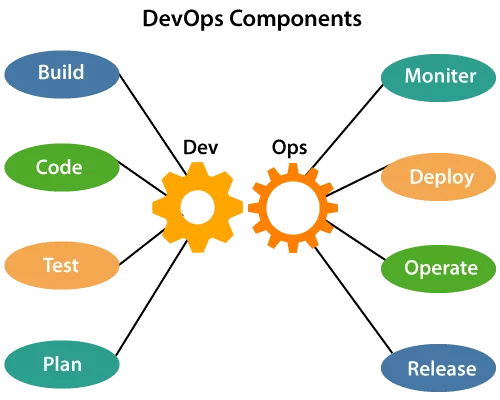Below are the various components that are used in the DevOps architecture:
1) Build
Without DevOps, the cost of the consumption of the resources was evaluated based on the per-defined individual usage with fixed hardware allocation. And with DevOps, the usage of cloud, sharing of resources comes into the picture, and the build is dependent upon the user’s need, which is a mechanism to control the usage of resources or capacity.
Build automation is the process of automating the retrieval of source code, compiling it into binary code, executing automated tests, and publishing it into a shared, centralized repository. Build automation is critical to successful DevOps processes.
2) Code
Many good practices such as Git enables the code to be used, which ensures writing the code for business, helps to track changes, getting notified about the reason behind the difference in the actual and the expected output, and if necessary reverting to the original code developed. The code can be appropriately arranged in files, folders, etc. And they can be reused.
3) Test
The application will be ready for production after testing. In the case of manual testing, it consumes more time in testing and moving the code to the output. The testing can be automated, which decreases the time for testing so that the time to deploy the code to production can be reduced as automating the running of the scripts will remove many manual steps.
4) Plan
DevOps use Agile methodology to plan the development. With the operations and development team in sync, it helps in organizing the work to plan accordingly to increase productivity.
5) Monitor
Continuous monitoring is used to identify any risk of failure. Also, it helps in tracking the system accurately so that the health of the application can be checked. The monitoring becomes more comfortable with services where the log data may get monitored through many third-party tools such as Nagios.
6) Deploy
Many systems can support the scheduler for automated deployment. The cloud management platform enables users to capture accurate insights and view the optimization scenario, analytics on trends by the deployment of dashboards.
Deployment is a step to make your code (developer’s code) live, after deployment you should be able to test your code in real environment (staging or production).
7) Operate
DevOps changes the way traditional approach of developing and testing separately. The teams operate in a collaborative way where both the teams actively participate throughout the service lifecycle. The operation team interacts with developers, and they come up with a monitoring plan which serves the IT and business requirements.
Operate. The operate phase involves maintaining, monitoring and troubleshooting applications in production environments. In adopting DevOps practices, teams work to ensure system reliability, high availability and aim for zero downtime while reinforcing security and governance.
8) Release
Deployment to an environment can be done by automation. But when the deployment is made to the production environment, it is done by manual triggering. Many processes involved in release management commonly used to do the deployment in the production environment manually to lessen the impact on the customers.
